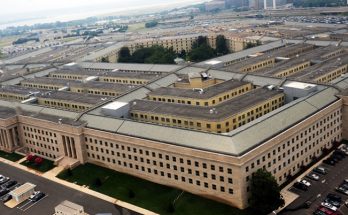Overnight on January 7, the Islamic Revolutionary Guard Corps conducted a missile strike on several bases in neighboring Iraq that house American and other international troops, carrying out a revenge operation for the killing of IRGC Quds Force commander Qassem Soleimani. The main focus of the attack was the Ayn al-Assad air base, located in Anbar Province, with other missiles targeting the base in Erbil. As many as 16 missiles were fired, U.S. Defense Secretary Mark Esper said, with 11 of these hitting Ayn al-Assad.
In a statement the following day, U.S. President Donald Trump said that no American or Iraqi lives had been lost as a result of the strikes. Iranian state-owned media, meanwhile, have sought to put the death toll at 80 American troops. The latter of the two seems highly unlikely. Planet Labs published satellite imagery after the strikes that showed damage to Ayn al-Assad, primarily centering on aircraft maintenance hangars.


Gauging the Iranian intent is a bit less straightforward. Some U.S. and European government sources told Reuters that Iran intended to miss American personnel. But the chairman of the Joint Chiefs of Staff, Gen. Mark Milley, said that he believed Iran “intended to cause structural damage, destroy vehicles and equipment and aircraft, and to kill personnel.” The U.S. had ample warning in advance that Iran was going to carry out attacks. The U.S. had reportedly seen Iran moving missiles ahead of time. Before the launches, the U.S. had reportedly discovered the planned salvo through intelligence sources, as well as from direct warning from Iraq, which Iran had warned prior to the attack. President Trump noted that “an early warning system” helped ensure that American personnel were not at risk once the missiles were fired.
Presumably, Iran would have been aware that warning Iraq about the strikes carried with it the possibility that Iraq would inform the U.S. of the attack. It might also have been able to assume the U.S. would find out about the strikes through other means as well. But even so, Iran very clearly chose targets within Ayn al-Assad that might matter – rather than simply striking within the vicinity of the base purely to send a message – which could have conceivably risked casualties in the process, particularly if the assumptions listed above had proven incorrect or the missiles struck unintended positions.
In any case, Iranian Foreign Minister Javad Zarif said after the attacks that Iran’s retaliation for the killing of Qassem Soleimani had been “concluded,” suggesting that Iran views the missile strikes as having adequately sent a warning to the U.S. and re-established Iranian deterrence. Some have warned that his comment might only refer to direct Iranian action, while leaving the door open for indirect action, such as leveraging Iraqi or other militias for violent activities, though U.S. Vice President Michael Pence made a point to say that U.S. intelligence points toward Iran seeking to restrain its militias, too. That may not last, but even a temporary ceasefire between the U.S. and Iran should help cool the war talk hysteria.
It is too soon to say that the immediate crisis between the U.S. and Iran is over. Whether a breather is in store should become much clearer over the course of the coming days and weeks. It’s plausible that both the U.S. and Iran can point to having “won” something out of this confrontation, which, as The Diplomat senior editor Ankit Panda pointed out, is not all that dissimilar from the standoff between Pakistan and India, which took place in late February last year. In that circumstance, in retaliation for a terrorist attack earlier in the month, India carried out air strikes that hit Pakistani soil, prompting an aerial skirmish between the two air forces during which an Indian MiG-21 was shot down. (Both sides claim additional aircraft were downed, but there is only evidence for the MiG-21.) In that standoff, as with the U.S. and Iran, it proved possible for the two rivals to walk away from escalation claiming success, without either being humiliated. That is important, as it lessens the need for leadership to escalate the situation over concern about being perceived as weak, but it is quite risky, as it relies on making a precise calculation about how to respond enough to appease local hardliners while not hitting hard enough to provoke the other side further.
The broader question of de-escalating tension between the U.S. and Iran remains. As he made his statement on the Iranian strikes, President Trump led by promising that Iran will never be able to produce a nuclear weapon. He called on the other members of the 2015 nuclear accord with Iran – the U.K., France, Germany, Russia, and China – to leave that deal and join with him in forging a new one. It’s not yet clear whether they will do so, as so far they have all sought to salvage the current deal. But as it falls further apart, President Trump is banking on them having no other choice. The U.S. left the accord in May 2018 and re-imposed sanctions on Iran. Tehran gave the other members of the deal a year to decide whether to stay in it and then began relaxing its own compliance with the terms of the deal, taking incremental steps to increase enrichment levels and build up its stockpile of enriched uranium.
Might the stage be set for new nuclear talks? Perhaps not quite so fast. The mood between the two countries is still sour. While some Iranian officials have signaled that the missile strikes constitute the entirety of Iran’s retaliations, others warn of “harsher revenge” still to come.
Additionally, the timing for talks may not be right. Both Presidents Trump and Hassan Rouhani are nearing the end of their terms (President Trump’s first, President Rouhani’s second and final). A new agreement with Iran might help President Trump shore up his foreign policy record ahead of the election, but it would have to be struck within 10 months, which seems difficult, especially if the terms of the 2015 deal are to be substantially rewritten. President Trump has been cagey about what he wants from a deal. He could seek a “quick fix,” perhaps just extending some of the expiring provisions from the 2015 accord, but in statements about the nuclear deal he has also looped in Iran’s missile inventory and regional foreign policy, which would take substantially longer to negotiate over. Iran has declared its missiles off-limits for discussions and the recent salvo underscores why: they form a crucial aspect of Iran’s deterrence. Moreover, President Trump can be expected to be weighing the potential boost to his re-election prospects from a deal against the fact that if he wins, he would have a stronger negotiating hand after the election.
President Rouhani, meanwhile, has been criticized as having oversold the windfall of the 2015 deal. The agreement yielded little in the way of economic benefits, but saw Iran significantly reduce its enrichment activity, and then the U.S. walked away. Would Iran’s Supreme Leader, who holds sway over the country’s foreign policy (and presidential picks), be willing to give Rouhani another stab at a deal? He could choose instead to wait for a new government, which will be elected in 2021.
The signal to watch for, in determining whether the parties believe that there is space for talks, is movement on sanctions policy. Nominally, both countries are “open” to talking, but Iran has sought for the U.S. to remove some of its sanctions prior to the start of negotiations, whereas the Trump administration has sought dialogue absent preconditions, content to leave the sanctions as they are. So far, Iran has not shown willingness to budge from its stance and, after the Iranian missile strikes, President Trump announced “powerful” new sanctions on Iran to add to those already in place. His comments show that his stance on negotiations remains exactly where it was before this latest flare-up.
Should either country change approach – either Iran dropping the sanctions prerequisite or the U.S. removing some sanctions – that will be a sign of a willingness to negotiate. Until then, the situation remains in flux, with alternating instances of tension and temporary ceasefire.
Military markets analyst, covering Eurasia, Middle East, and Africa.




